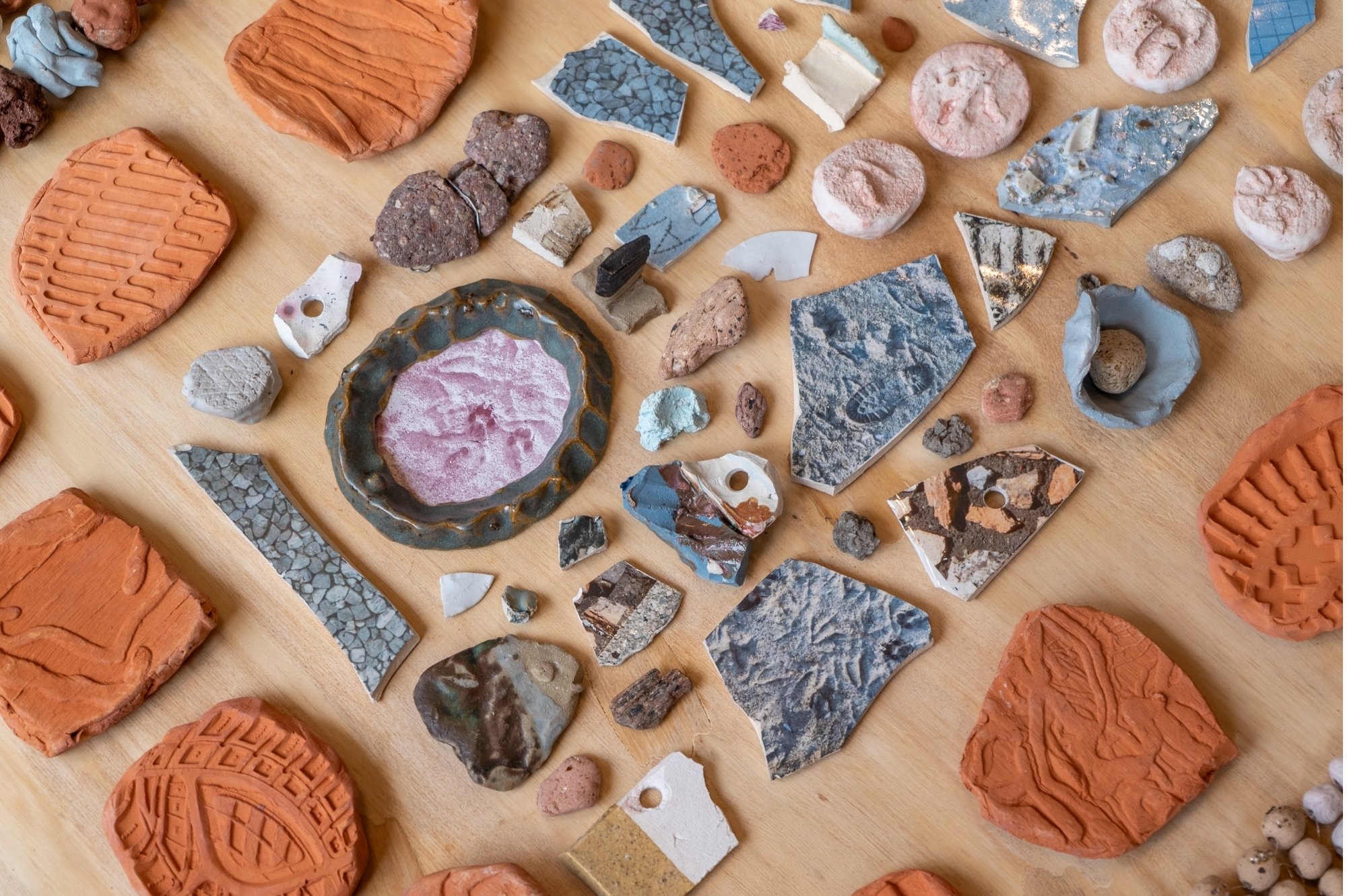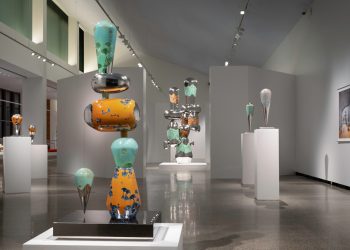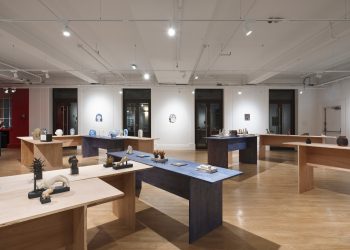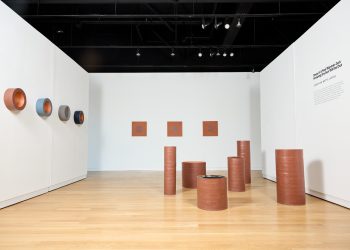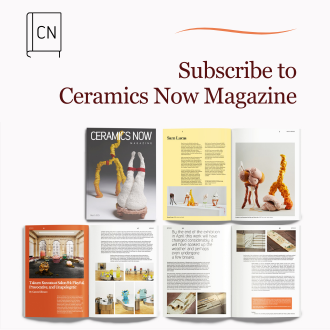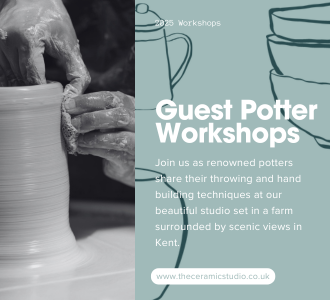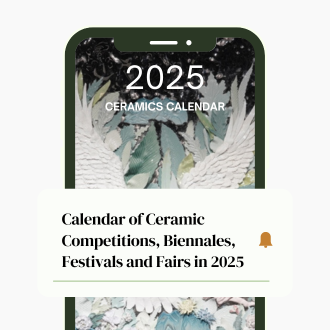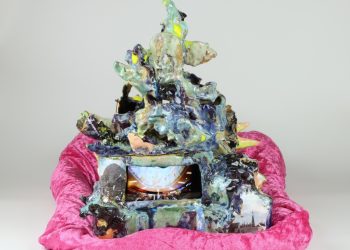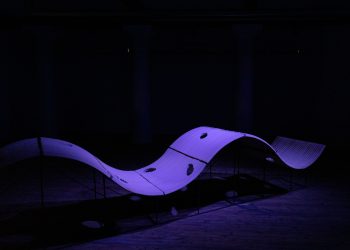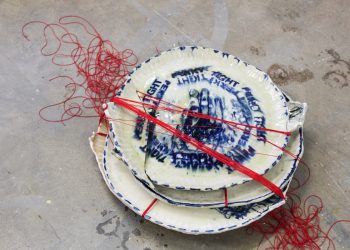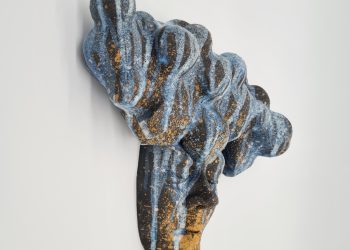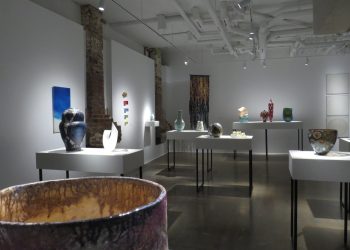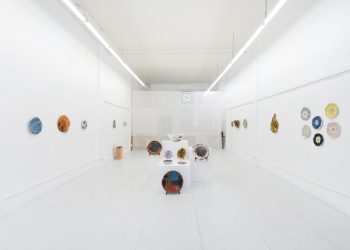By Katherine Ross
In Tracing Ways, artists E. Saffronia Downing and Rosemary Holliday Hall embrace a collaborative approach to materiality, exploring themes of place-making and site-specificity. Using clay, found objects, and collected traces, their installation maps the relationships between makers, matter, and the environment. This review by Katherine Ross examines how the artists reimagine material as a vessel for presence, process, and transformation.
Tracing Ways is a collaborative, site-specific installation by E. Saffronia Downing and Rosemary Holliday Hall at Comfort Station in Chicago, Illinois, on view between December 7, 2024, and January 5, 2025.
“Paying attention is a form of reciprocity with the living world, receiving the gifts with open eyes and open heart.”
Robin Wall Kimmerer, Braiding Sweetgrass
The artists have been in conversation with each other and collaborating for at least five years. Hall’s background is in printmaking and environmental horticulture, and Downing is a ceramist. Both are fluent in the practice of clay/ceramics but neither of them pursues an orthodox approach to the material. They are travelers, collectors and observers of their environment. Their practices are based in the act of walking, in noticing and making connections. Hall’s interdisciplinary, sculpture and performance practice leans towards an interest in science, geology and nonhuman activities. Downing uses the language of craft processes in much of her collections of things extracted during her travels.
They met in Chicago and co-founded Viral Ecologies, an online curated publication during the Covid-19 pandemic. The first issue in 2020 examined the relationship between bodies and landscapes. The second issue considered the complex systems derived from small actions, attentions or explorations. Other issues focused on scientists and climate, geologic examinations, and craft ecologies. All of these topics are integral to Hall and Downing’s project at Comfort Station.
They left Chicago, Hall to the west, eventually to Ojai, California and Downing to the east, settling in the Hudson Valley of New York. They reunited in Chicago for Tracing Ways, where they combine and weave together their collections of traces and tracks of their movements through landscapes on opposite coasts. The artists’ bodies record movements across environments alongside nonhuman bodies also travelling across places and time.
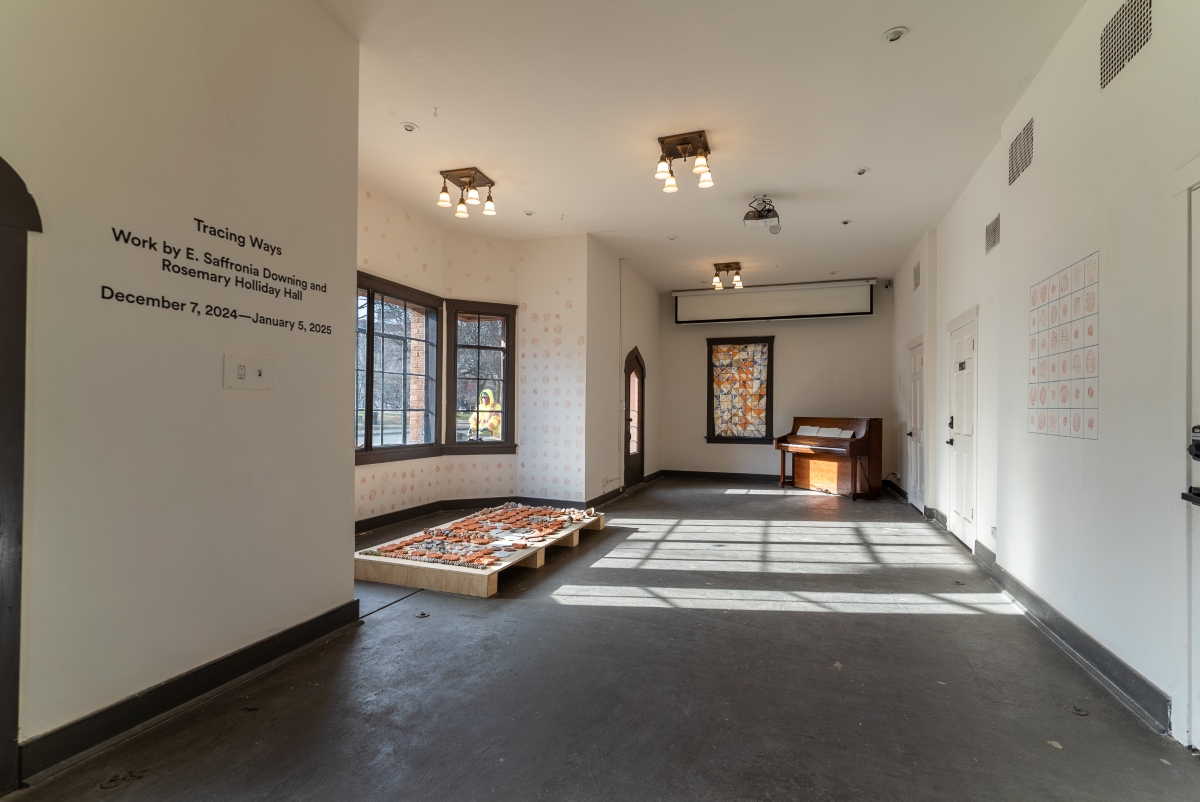
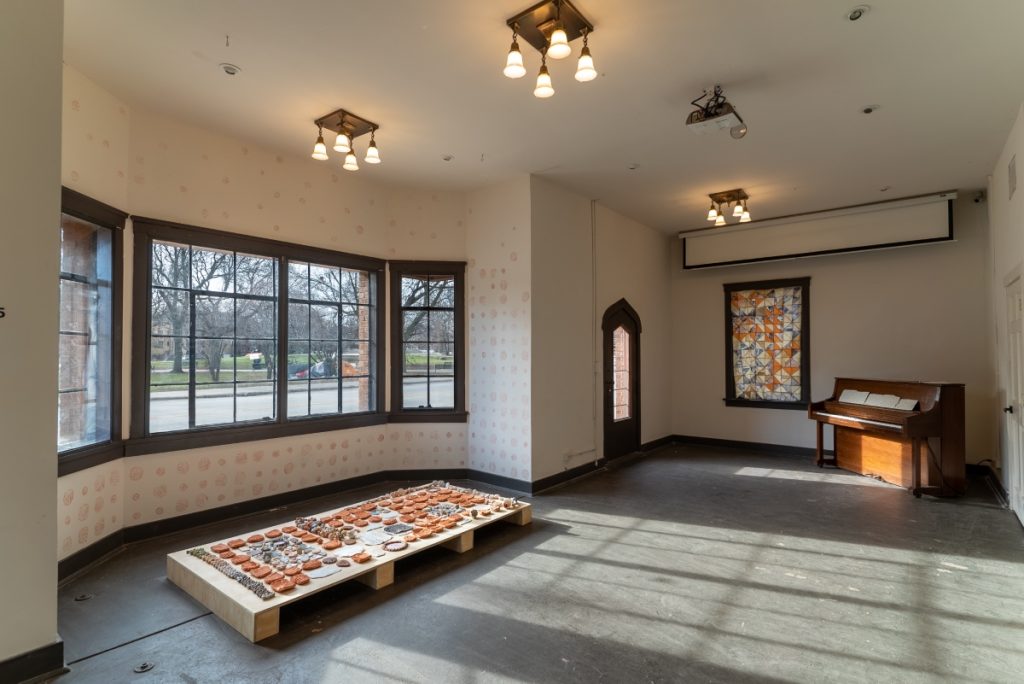
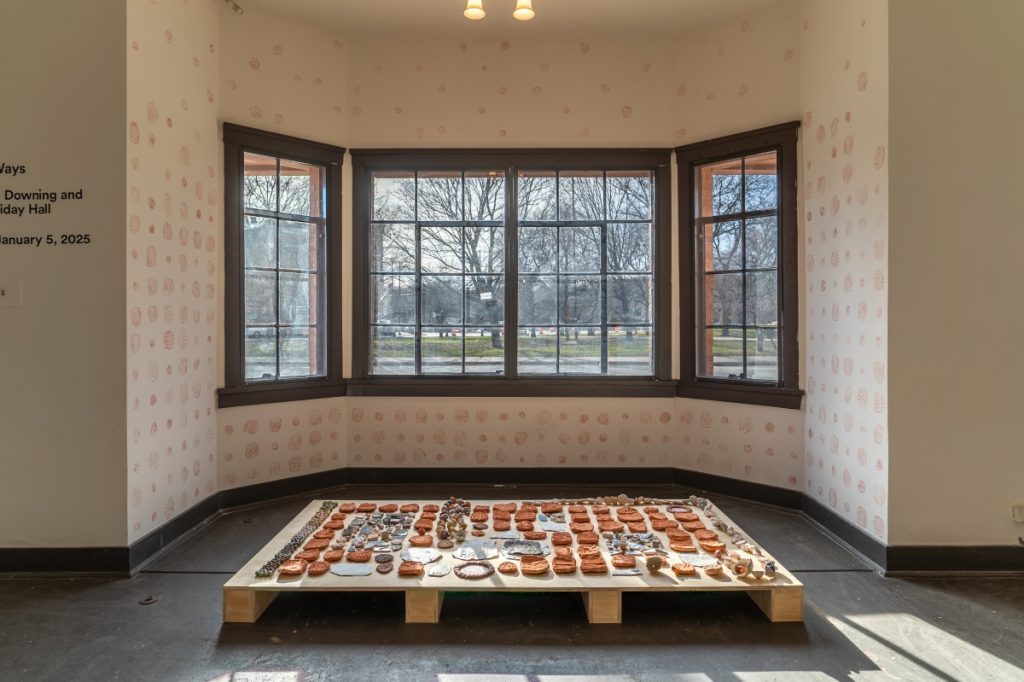
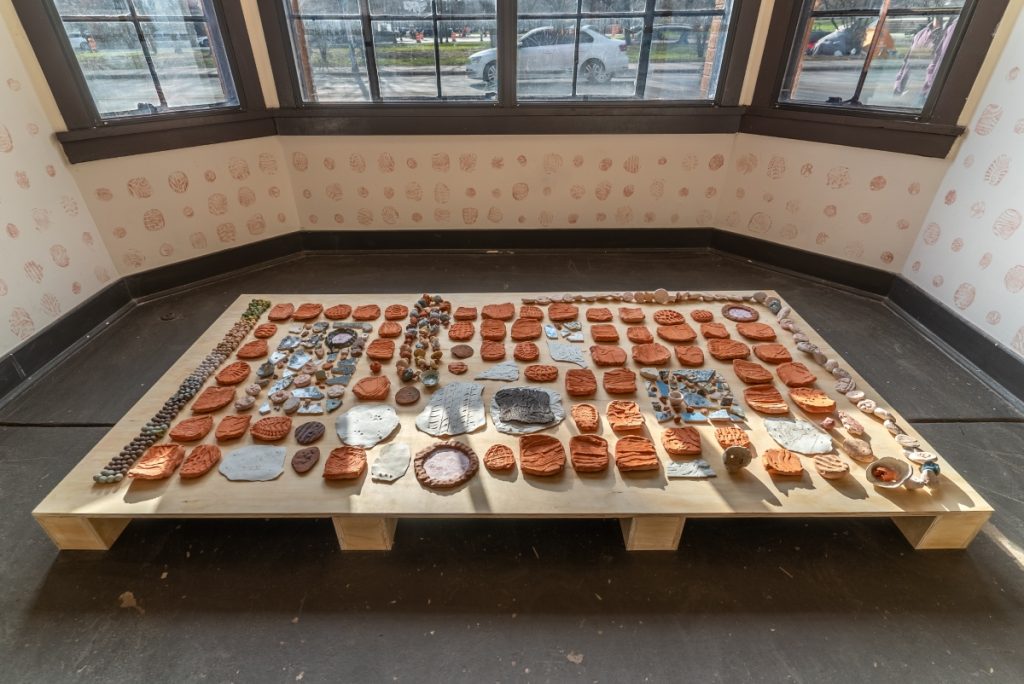

“Wandering re-establishes the original harmony which once existed between man and the universe.”
Anatole France
The installation at Comfort Station includes fired clay impressions of human shoe prints, perhaps the artists’ and others that came before them and left these marks. Impressions in clay of animal footprints- rats, dogs, cats, squirrels, geese, doves, insect tracks bored through the surface of eucalyptus trees, tire tracks, spider webs, and samples of wild clay collected along the way are arranged alongside porcelain impressions and glazed fragments with photographic glaze decal surfaces. I am aware of time and distance, permanence and transience, geologic and cultural time. Movement from one place to another in a series of tracks or footprints is reinterpreted by pressing clay into the fired clay impressions and then pressing onto the gallery wall in a grid array, leaving a faint clay stamp residue of the shoe in clay. The grid is a method of organization, a particular but momentary configuration making important the fragments of residual memory. Wild clay collected and formed into beads and strung on wire is an organizational strategy from a craft practice, as is the quick fashioning of a tiny pinch pot from a wad of site-specific clay. Most of these samples/collections are arranged on a very low, raw plywood platform. The connection to the floor and further, to the earth below, is implicit. I noticed that the plywood refers to trees in nature but was removed and transformed into a construction material. The reinterpretation of the collected objects from the original geographic locations to off-site and in relation to one another, the viewer and the collector is a continuum, not final but existing on a spectrum of relationships in time.
Wild and industrially processed clays and porcelain figure in the exhibition as reminders of both the histories of making and geologic history. Clay is the recording device; a strategy that equalizes the significance of all that the clay records. One object is not more or less impactful than another. Meaning is in the relationship of all the components.
Clay pits and brick factories were common in the Chicago area a century ago but do not operate today. Clay was and is transported all over the world through human activity. The earth itself transports clay through erosion and glacial, air and water movement. Animals, birds and insects move earth and clay and construct their homes from it. Architecture is built and demolished. Brick rubble is returned to pits as refuse and material to be recycled. Both Hall and Downing collect, track and reflect on these materials, activities and histories and the interrelationships of human and nonhuman beings to their environment.
“The aim of art is to represent not the outward appearance of things, but their inward significance.”
Aristotle
A piano is playing, controlled by Bret Scheider’s electronic intervention in collaboration with Hall. Resting on the piano are porcelain tiles that were pressed onto the burrowed tracks of beetles on eucalyptus wood. Scheider transposed the patterns of the insect tracks into a score playing on the piano.
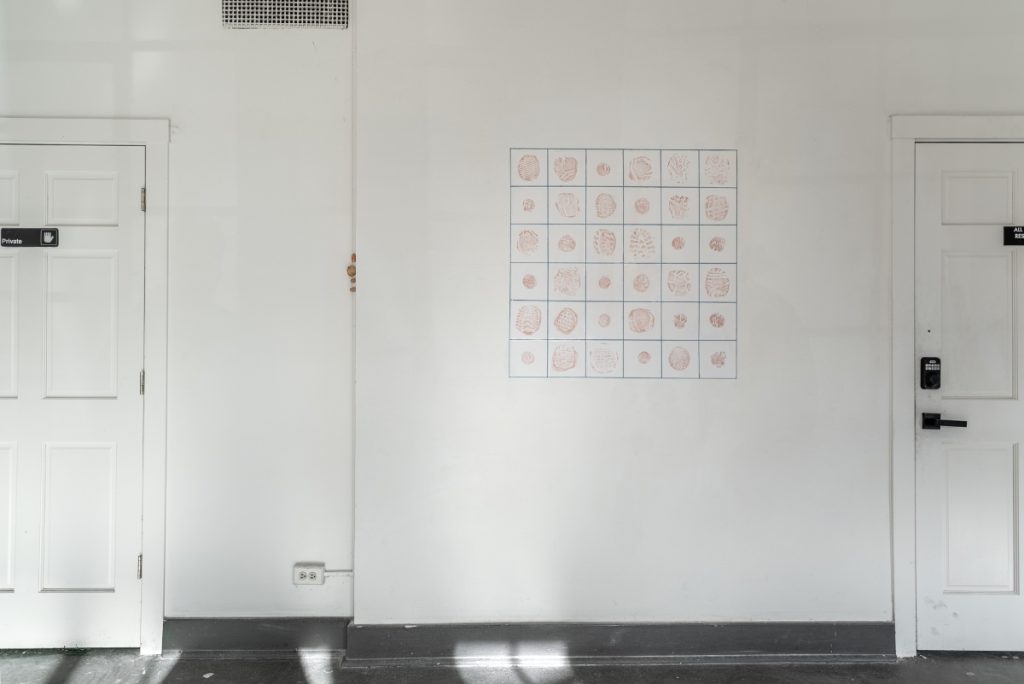
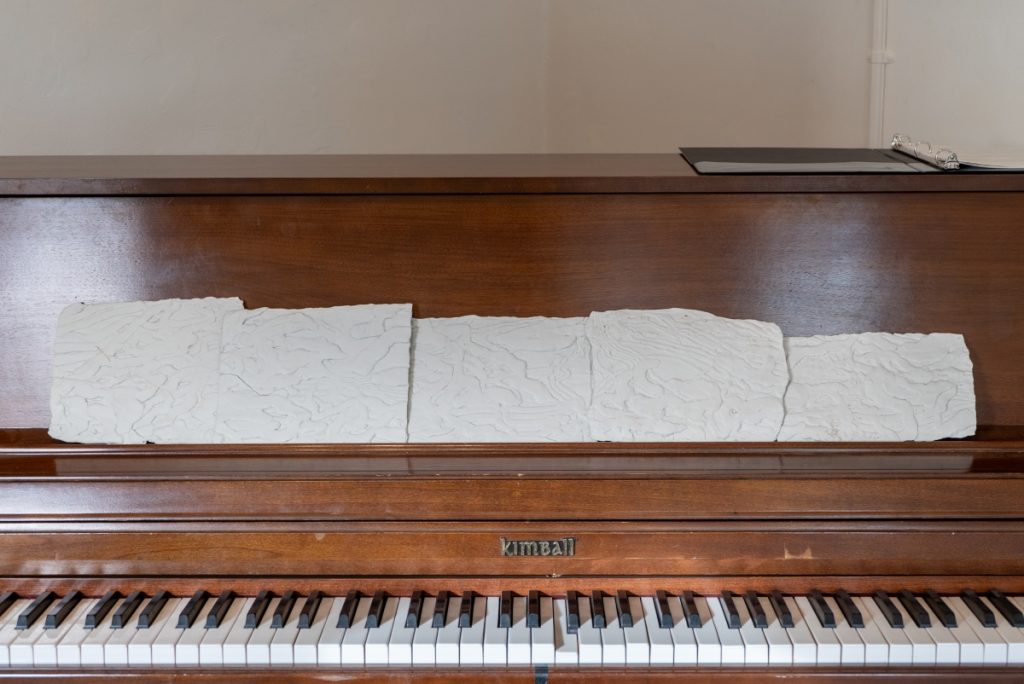
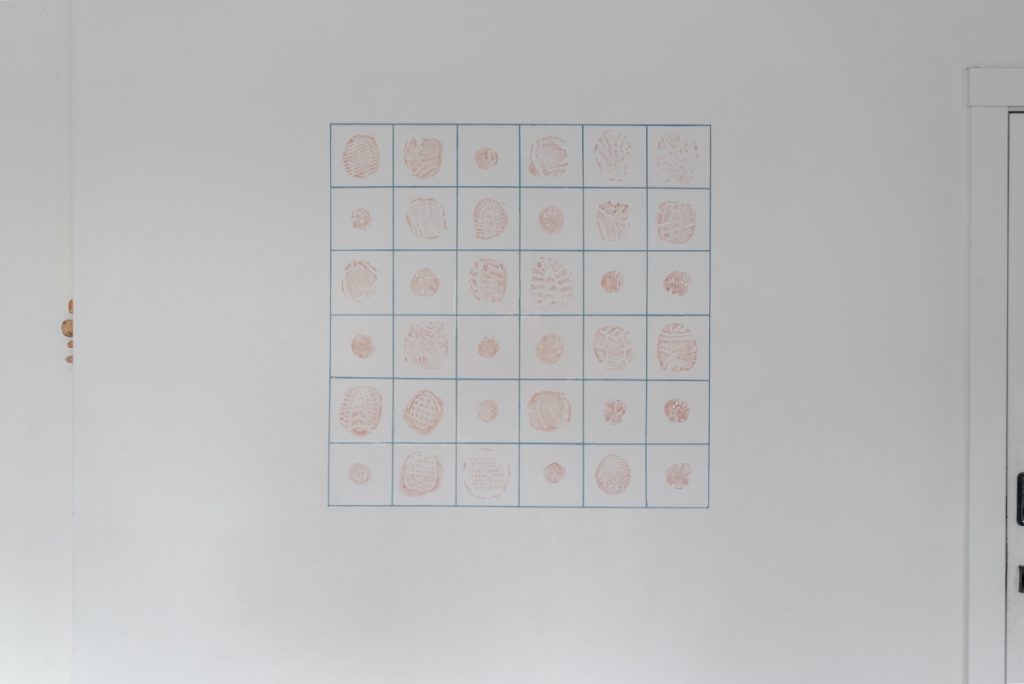
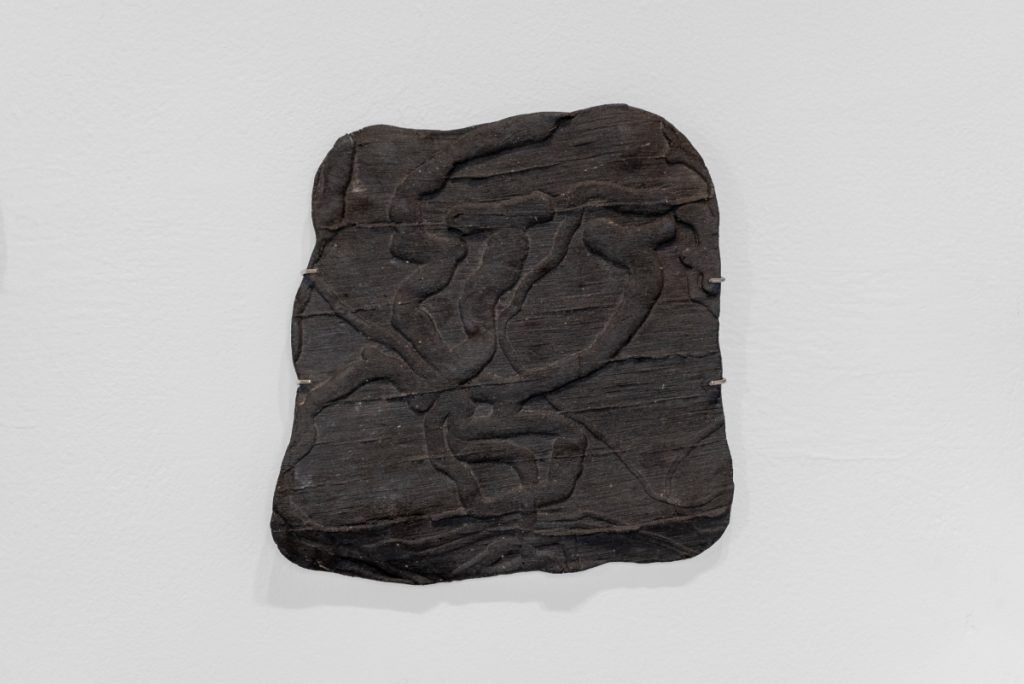
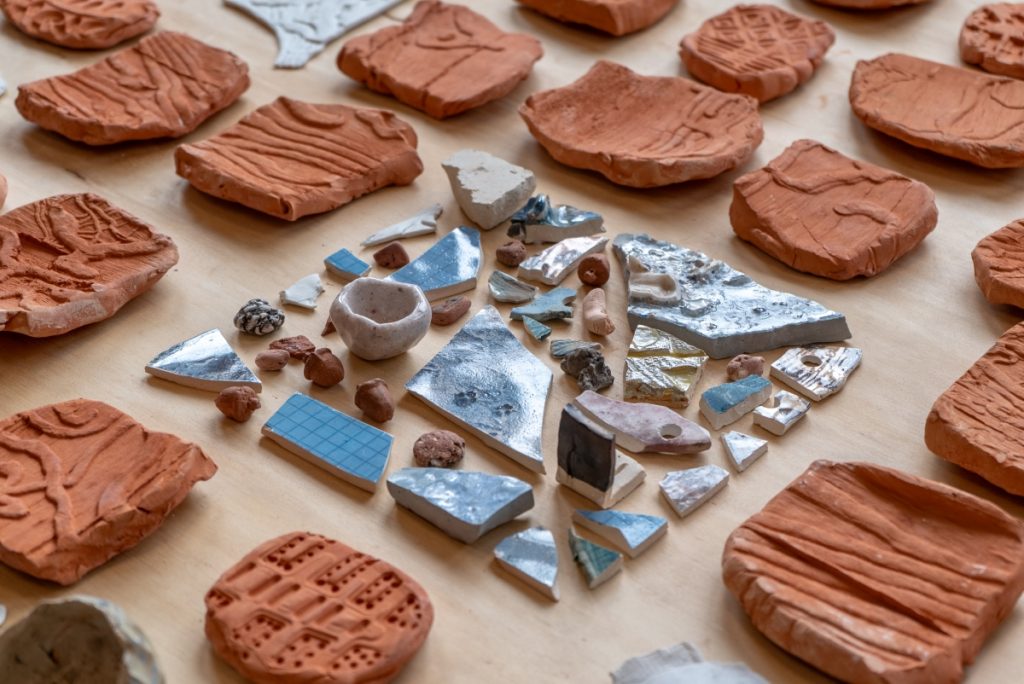
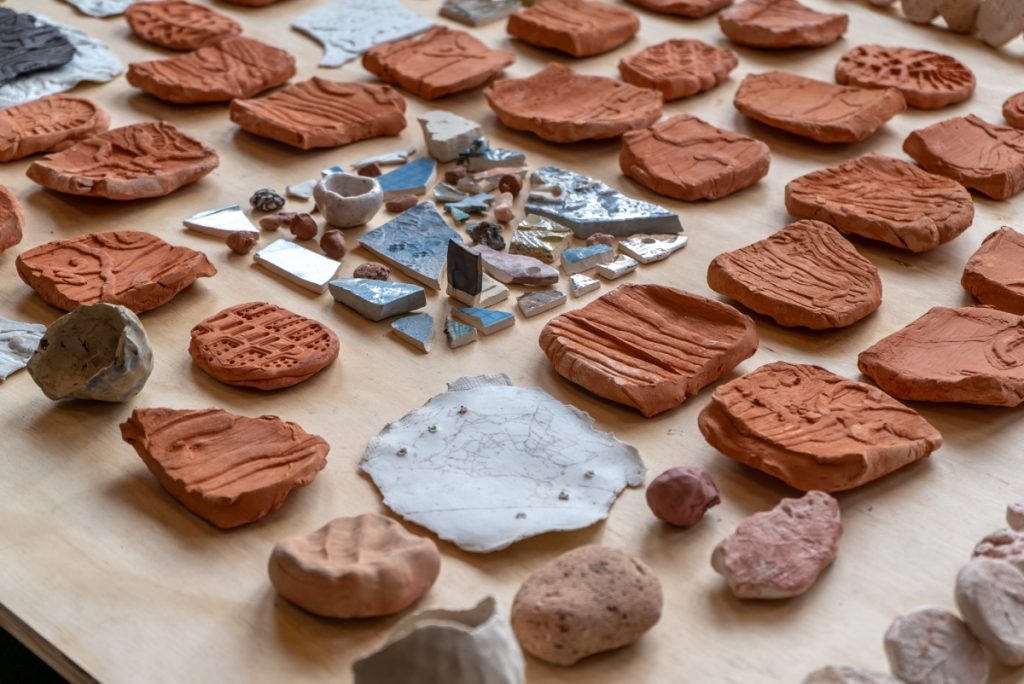
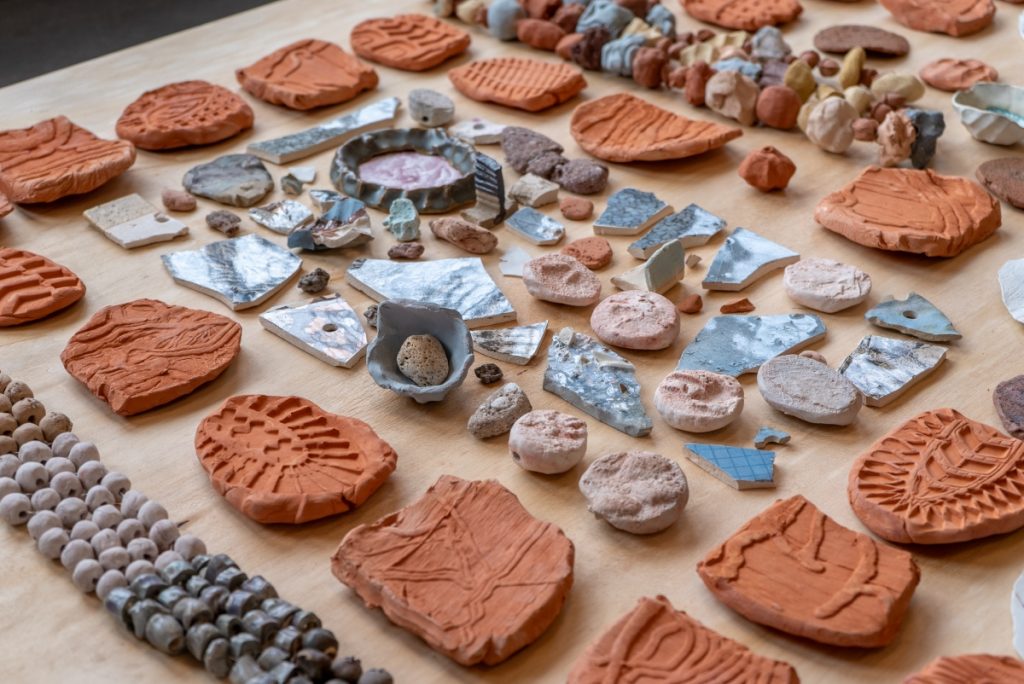
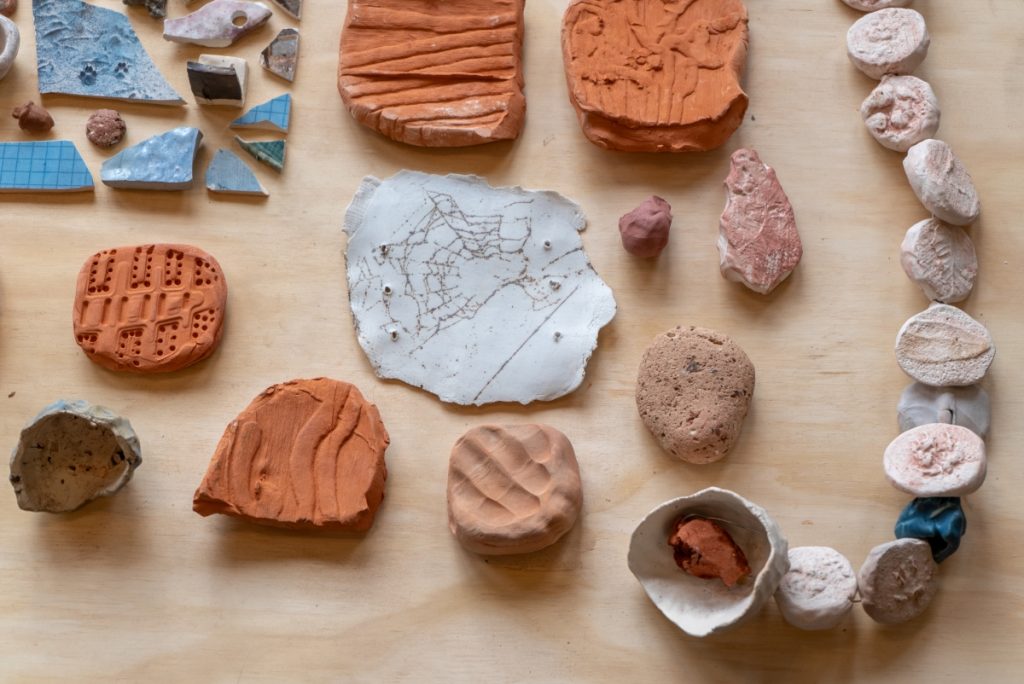
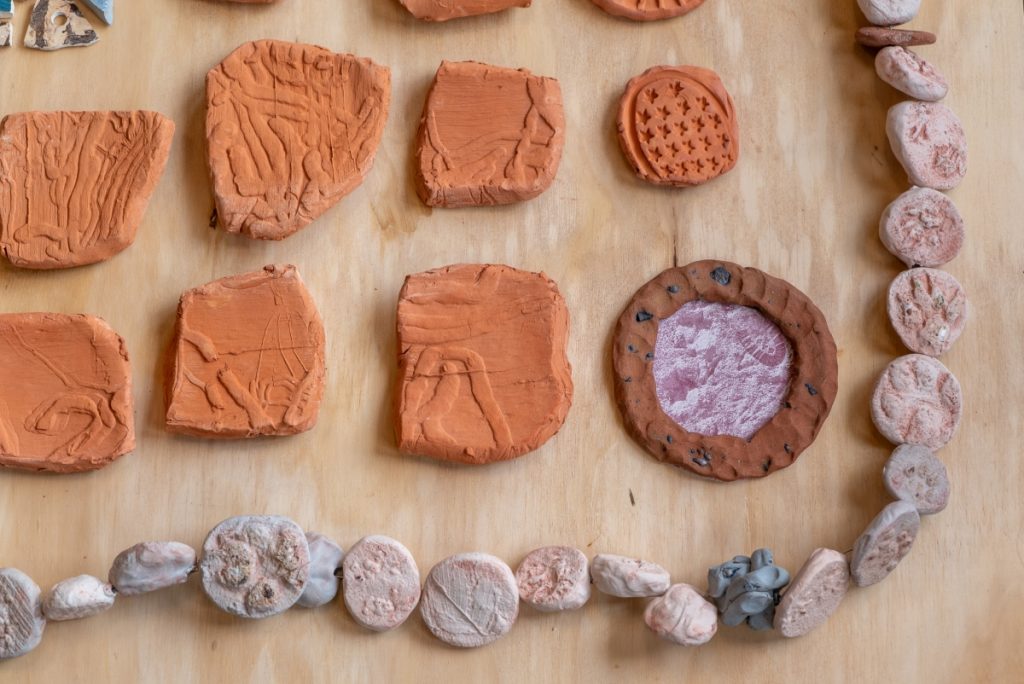
“A track feels like witnessing a ghost—an absent presence etched into the material landscape. In this performance, the path of burrowing beetles is transcribed into musical notation, then played by a player piano, as through by a spectral hand.”
Rosemary Holliday Hall
The pieces on the gallery wall imply a relationship to this specific architecture. This brings me to the importance of the site of the gallery to the concept of the exhibition. A fabric quilt with photographic prints of earth surfaces is hung over a window in the gallery. Sunlight comes through the thin fabric metaphorically bringing the outside world into the gallery. A quilt implies contact with a body, warmth and comfort. Comfort Station was built in 1927 on Milwaukee Avenue in the Logan Square neighborhood of Chicago. It is one of two remaining of the original nine small Tudor-style buildings built to serve travelers on the west side trolley lines. The 700-square-foot building was a place for people to get out of the rain, the heat, or the cold, use the restroom, and wait for the next trolley car.
I drove to the exhibition opening from my rural home in the woods of Indiana to the gridded pavement of Chicago. The Comfort Station appeared on a small patch of green, a building out of time in the contemporary city. The drive gave me time to think about clay, about movement, about time, and about relationships. Living in the woods, I walk on clay every day, and I see it. In Chicago, I walk on pavement, but I know that underneath it is all clay. Like my home, the clay in Chicago was brought and deposited by ice age glaciers. Approaching the Comfort Station building I moved across a patch of grass and was reminded of the clay underfoot. Next to the building were three tents, provisional homes for the unhoused taking refuge by the station. Stepping inside the building I was ready and prepared to engage in the conversation the work would offer. Tracing Ways tells stories, makes connections, looks far into the landscape and lingers in the details.
“We do not obtain knowledge by standing outside the world; we know because “we” are of the world. We are part of the world in its differential becoming.”
Karen Barad, Meeting the Universe Halfway
Katherine L. Ross is a visual artist and writer, and Professor Emeritus at the School of the Art Institute of Chicago. She is a member of the International Academy of Ceramics, Geneva, Switzerland, an invited member of the International Arts & Design Experts Committee of the Academy of Arts & Design, Tsinghua University, Beijing, and an advisor for the A-B Projects Ceramic Certificate program. Her new book, The Erasure of Mikhail Yeyegov is published by NFB Publishers.
Tracing Ways was on view at Comfort Station, Chicago, between December 7, 2024, and January 5, 2025.
Subscribe to Ceramics Now to read similar articles, essays, reviews and critical reflections on contemporary ceramics. Subscriptions help us feature a wider range of voices, perspectives, and expertise in the ceramics community.
Photos by Mikey Mosher.


